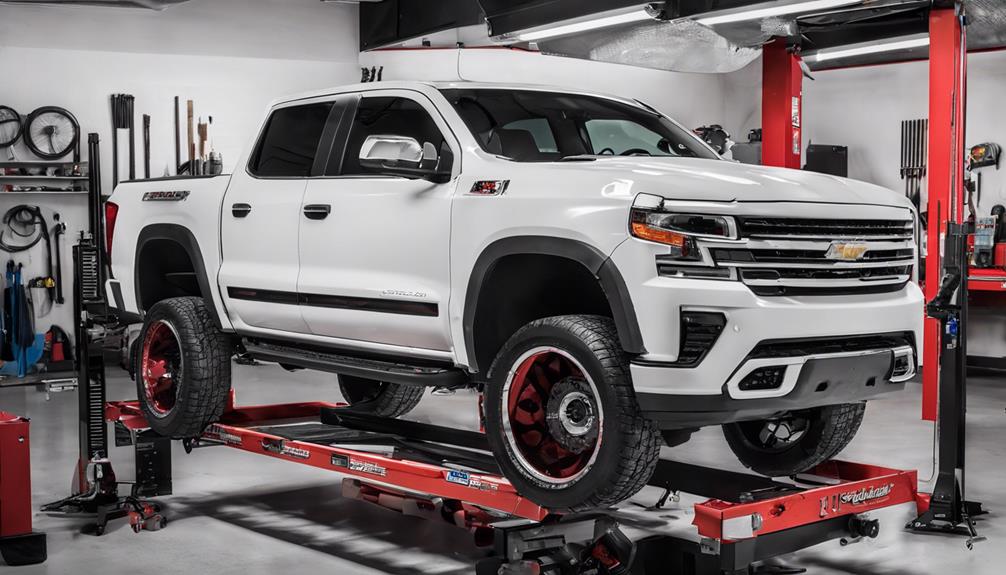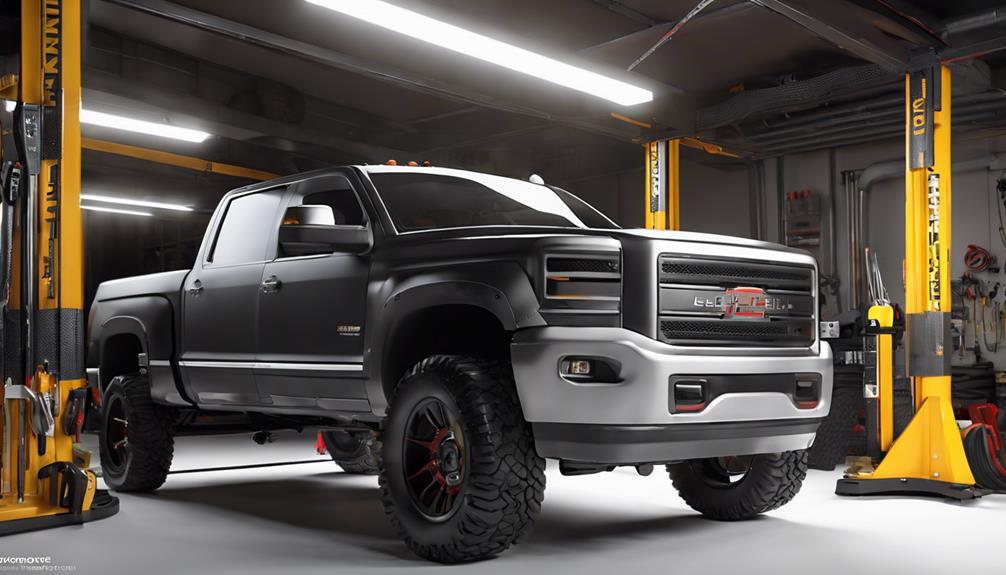Imagine the sun setting over McAllen, TX, as you finally decide to elevate your vehicle’s stance with a lift kit, transforming it into the towering beast you’ve always envisioned. You’re about to embark on a journey that’ll not only enhance your vehicle’s appearance but also its off-road capability. However, the process can be intricate, involving more than just choosing the right kit and bolting it on. From preparation to post-installation checks, there’s a wealth of knowledge to navigate. Stick around to uncover key insights and maintenance tips that’ll ensure your lift kit installation is as smooth and effective as possible.
Key Takeaways
- Select a lift kit that matches your vehicle’s make, model, and year for optimal compatibility.
- Thoroughly clean your vehicle and prepare a safe workspace before starting the installation process.
- After installation, ensure your vehicle’s alignment and tire balance are checked to maintain a smooth driving experience.
- Maintain your lift kit with regular inspections and lubrication to ensure long-term performance and safety.
Choosing the Right Kit
Selecting the appropriate lift kit for your vehicle in McAllen, TX, requires understanding your vehicle’s specifications and your desired performance outcomes. You’re not just choosing a lift kit; you’re customizing your ride to suit your unique needs and tastes. It’s a technical endeavor but also a deeply personal one.
Kit compatibility is paramount. Each vehicle has its specific requirements and limitations. You’ll need to delve into the nitty-gritty of your vehicle’s make, model, and year to ensure the lift kit you’re eyeing is a perfect match. Don’t overlook this step; an incompatible kit can lead to poor performance or, worse, damage to your vehicle.
Budget considerations are equally crucial. It’s easy to be swayed by high-end options, but it’s essential to find a balance between quality and affordability. Remember, the cost doesn’t end with the purchase; installation and potential adjustments should also be factored into your budget. You’re investing in your vehicle’s future, so choose wisely.
In this intimate journey of upgrading your vehicle, technical precision and a clear understanding of your priorities will guide you to the right choice.
Preparing Your Vehicle
Before you embark on the installation of your chosen lift kit, it’s crucial to properly prepare your vehicle, ensuring a seamless and efficient upgrade process. This preparation is not just about getting your tools in order; it’s about creating a connection with your vehicle and understanding its intricacies before you enhance its stature.
Vehicle preparation starts with a thorough cleaning. You’ll want to remove any dirt, grime, or debris that could hinder your access to the vehicle’s undercarriage or obscure important mounting points. This isn’t just about aesthetics; it’s about ensuring nothing interferes with your work.
Next, gathering your tools is essential. This isn’t just about having the right wrench or socket; it’s about knowing each tool’s role in your upgrade journey. Below is a table summarizing the initial steps and tools needed:
| Step | Description | Tools Needed |
|---|---|---|
| Cleaning | Remove dirt and grime from the vehicle | Soap, Water, Brushes |
| Inspection | Check for any pre-existing issues | Flashlight, Inspection Mirror |
| Tool Gathering | Assemble necessary tools for the job | Wrench Set, Jacks, Stands |
| Workspace Prep | Ensure a clean, safe area for work | Cleaning Supplies, Safety Gear |
| Mental Prep | Ready yourself for the task ahead | Manuals, Instructional Videos |
Installing the Lift Kit

Once you’ve prepared your vehicle and gathered all the necessary tools, it’s time to tackle the heart of the project: installing the lift kit. This step is where your preparation pays off, and your vision starts to take shape. Remember, tool selection and legal considerations are crucial at this stage. You’re not just modifying your ride; you’re ensuring it’s safe and compliant.
Here’s a clear path forward:
- Review Your Kit’s Instructions: Every lift kit is unique. Familiarize yourself with the specific steps and tool requirements. This isn’t the time for guesswork.
- Suspension Disassembly: Carefully remove the existing suspension components. Organize and label parts to avoid confusion during reassembly.
- Install the New Components: Begin with the larger components, typically the shocks and springs, then move to the smaller parts. Ensure all components are securely fastened.
- Legal Check: Before you proceed further, it’s wise to review local regulations concerning vehicle modifications. Ensure your lift meets any height restrictions and safety requirements.
Precision, patience, and adherence to guidelines are your best friends here. Don’t rush the process. Each step you take brings you closer to that thrilling moment when you see your vehicle transformed.
Post-Installation Checks
After installing your lift kit, it’s crucial to perform comprehensive post-installation checks to ensure everything is properly aligned and secure. You’ve embarked on a transformative journey with your vehicle, and now, it’s time to cross the t’s and dot the i’s to guarantee a smooth, safe ride.
First off, alignment verification is paramount. A lift kit alters your vehicle’s geometry, which can throw off the alignment. You’re aiming for precision here; even a slight misalignment can lead to uneven tire wear and a compromised handling experience. Use a trusted alignment tool or seek professional help to adjust your vehicle’s angles back to the manufacturer’s specifications.
Next, focus on tire balance. The addition of a lift kit can impact the distribution of weight across your tires. An unbalanced tire can cause vibrations, leading to driver fatigue, increased wear on suspension components, and a decrease in fuel efficiency. Ensure each tire is meticulously balanced for an even ride. This step not only enhances your driving experience but also prolongs the life of your tires and suspension system.
Maintenance Tips

To ensure your vehicle’s performance remains optimal after installing a lift kit, it’s crucial to keep up with regular maintenance routines. Here are four key steps you should follow:
- Check Tire Pressure Regularly: After a lift kit installation, your vehicle’s weight distribution alters, which can affect tire pressure. It’s vital to check your tire pressure frequently to prevent uneven wear and tear. Ideally, you’d want to maintain the pressure recommended by the tire manufacturer, as this ensures your lifted vehicle handles as intended.
- Regular Wheel Alignment Checks: Lift kits can significantly change your vehicle’s suspension geometry. To avoid uneven tire wear and ensure your vehicle drives straight, it’s critical to have your wheel alignment checked and adjusted if necessary. Aim for a professional check at least twice a year or after any off-road adventure.
- Suspension Component Inspection: Periodically inspect all newly installed components for any signs of wear or damage. Pay special attention to bolts and nuts, ensuring they’re tight and secure. This prevents any unexpected failures while driving.
- Lubricate Moving Parts: To keep everything running smoothly, it’s essential to lubricate all moving parts within the suspension system. This includes joints and bushings, which can become dry and wear out faster without proper lubrication.
Frequently Asked Questions
What Are the Legal Implications and Regulations to Consider When Installing a Lift Kit in Mcallen, Tx?**
Ironically, while you’re aiming sky-high with your vehicle, McAllen, TX keeps you grounded with its legalities. Before you elevate your ride, you’ve got to navigate the maze of installation permits and lift height limits. It’s a technical journey requiring precision. Each detail, from the specific paperwork to the exact measurement restrictions, must be adhered to. Let’s get intimate with these regulations, ensuring your lifted vehicle doesn’t just dream of the clouds but legally cruises the streets.
How Does Installing a Lift Kit Impact My Vehicle’s Warranty and Insurance Coverage in Mcallen, Tx?**
When you install a lift kit in McAllen, TX, it’s crucial to consider how it affects your vehicle’s warranty and insurance coverage. Warranty specifics can vary, with some policies voided by modifications like lift kits. Meanwhile, insurance adjustments might be necessary to cover the altered vehicle adequately. You’ll need to review your agreements closely and possibly negotiate new terms to ensure you’re fully protected post-installation.
Can Installing a Lift Kit Affect My Vehicle’s Fuel Efficiency, and Are There Ways to Mitigate Any Negative Impacts in Mcallen, Tx?**
Yes, installing a lift kit can affect your vehicle’s fuel efficiency due to increased air resistance and weight. However, you’ve got options to counter this. Fuel additives can improve combustion efficiency, potentially offsetting some fuel consumption increases. Additionally, aerodynamic modifications, like streamlined bumpers or underbody panels, can reduce drag, helping your ride reclaim some of its lost efficiency. It’s about striking a balance between style and practicality in McAllen, TX.
What Are the Potential Safety Concerns With DIY Lift Kit Installations, and How Can I Ensure My Vehicle Remains Safe to Drive in Mcallen, Tx?**
When you’re tackling DIY lift kit installations, safety concerns can’t be overlooked. You’ve got to ensure your vehicle’s stability isn’t compromised, affecting its off-road performance and your safety. The installation process must be precise; incorrect fitting can lead to uneven tire wear or, worse, a loss of control. To keep your ride safe in McAllen, TX, consider professional installation costs as an investment in your safety and vehicle’s performance.
How Does the Choice of a Lift Kit Impact the Resale Value of a Vehicle in Mcallen, TX, and What Should I Consider if I Plan to Sell My Lifted Vehicle in the Future?**
Choosing the right lift kit can affect your vehicle’s resale value more than you’d think; in some markets, lifted vehicles can fetch up to 10% more. But here’s the catch: market trends in McAllen, TX, show that poorly chosen or installed kits can just as easily decrease value. Consider the installation cost and opt for a kit that enhances both performance and aesthetic appeal to ensure you’re making a sound investment for the future.

No Responses